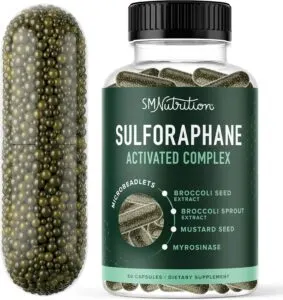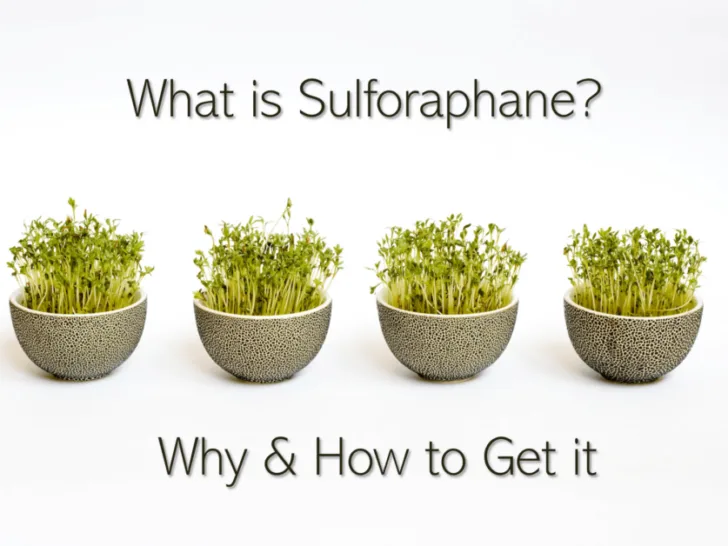Some of the links in this post are affiliate links. This means if you click on the link and purchase the item, we will receive an affiliate commission from the vendor at no extra cost to you. These business relationships allow us to keep bringing you great EatMoveHack content. All opinions remain our own.
Important Update: To serve you better, we’ve updated our partnership with Thorne. Now, instead of linking directly to individual products, we provide one central link to Thorne’s homepage. When you shop through this link, you’ll get an automatic 10% discount on all Thorne products at checkout. Just click the link and search for the product you want!
Sulforaphane, a sulfur-rich compound found in cruciferous vegetables like broccoli, bok choy, and cabbage, has garnered attention for its potential health benefits, including digestive and heart health support. While consuming these vegetables raw or lightly steamed can provide sulforaphane, supplements offer a convenient alternative, especially for those who may not enjoy these foods.
Understanding Sulforaphane and Its Precursors
Sulforaphane is produced when glucoraphanin, a naturally occurring compound in certain vegetables, interacts with the enzyme myrosinase. This interaction typically occurs when the vegetables are chopped, chewed, or otherwise processed. In supplement form, the bioavailability of sulforaphane—the proportion that enters circulation and can have an active effect—varies based on its formulation:
- Pure Sulforaphane: Approximately 70% bioavailability.
- Glucoraphanin with Myrosinase: Around 35% bioavailability.
- Glucoraphanin Alone: About 10% bioavailability.
These figures highlight the importance of supplement composition in maximizing sulforaphane intake.
Top Sulforaphane Supplements
When selecting a sulforaphane supplement, it’s crucial to choose products that combine glucoraphanin with myrosinase to enhance bioavailability. Here are some reputable options:
Avmacol
Avmacol combines glucoraphanin extracted from broccoli seeds with active myrosinase enzyme, enhancing sulforaphane production. Each pack contains 60 tablets, with a recommended dosage of two tablets per day.

Broccoli Seed Extract by Thorne Research
This supplement offers concentrated glucoraphanin, labeled as Sulforaphane Glucosinolate. It’s important to note that while it contains the precursor to sulforaphane, the conversion depends on the presence of myrosinase. Each bottle contains 60 capsules, with a suggested dosage of one capsule daily.
💡 Get Your 10% Discount at Thorne!
Click here, visit Thorne’s homepage, and simply search for “Broccoli Seed Extract” to find exactly what you need.

Pure Therapro Rx OncoProtect ES
Glucoraphanin is a dietary supplement designed to provide a concentrated dose of glucoraphanin, a naturally occurring compound found in cruciferous vegetables like broccoli. Glucoraphanin is the precursor to sulforaphane, a compound studied for its potential health benefits, including antioxidant properties and support for the body’s natural detoxification processes.

Growing Your Own Broccoli Sprouts
For those interested in a natural and cost-effective approach, growing broccoli sprouts at home is a viable option. Broccoli sprouts are particularly rich in glucoraphanin, and when consumed raw, they provide a substantial amount of sulforaphane. This method allows for control over freshness and preparation, ensuring maximum enzyme activity for sulforaphane production.
Considerations When Choosing Supplements
When selecting a sulforaphane supplement, consider the following:
- Bioavailability: Opt for supplements that include both glucoraphanin and myrosinase to enhance sulforaphane production.
- Quality Assurance: Choose products that have been tested for potency and purity.
- Storage and Stability: Be aware that myrosinase is an enzyme and may not be shelf-stable without proper storage conditions, potentially compromising its effectiveness.
Incorporating Sulforaphane into Your Routine
Incorporating sulforaphane into your diet through supplements or natural sources can be a beneficial addition to your health regimen. However, it’s essential to consult with a healthcare professional before beginning any new supplement, especially if you have underlying health conditions or are taking other medications.
For more detailed information on sulforaphane supplements and their benefits, you can visit reputable health websites or consult with a nutritionist.
Note: Always ensure that any supplements you choose are from reputable sources and have been tested for quality and efficacy.
Article Sources
- Chemoprotection Center At John Hopkins University FAQ
- Jed Fahey Interview on Rhonda Patrick’s Podcast
- Further publications from John Hopkins University research
P.S. Check out this post on supplements that Rhonda Patrick takes – these can make good additions to sulforaphane.


Pone
Tuesday 5th of June 2018
Wouldn't Rhonda's approach be better done by heating the water, immediately blending the sprouts at the target temperature, then putting the blending material back on the target temperature for an additional nine minutes? This was you expose the myrosinase to the sulforaphane precursors at the desired temperature and sustain the reaction for 10 minutes. Doing things as Rhonda does in the video, the myrosinase remains trapped in the fiber of the sprout and only gets activated when she blends, at which point she is not leaving it at the target temperature for 10 minutes.
Mark
Friday 12th of October 2018
Your suggestion isn't necessary. If you look at the paper Rhonda references, you'll find the explanation. Heating the sprouts intact to 70C reduces ESP activity so when blending afterward, less sulforaphane nitrile is formed, enabling an equivalent increase in myrosinase-catalyzed, formation of sulforaphane.
Curtis
Friday 11th of May 2018
If you grow your own sprouts, most mason jars cap threads will fit most blender screw-on bottom. I don't know the correct term for it. It's not the motor base, but the screw on that holds the teeth of the blender. So sprout away, add stuff in the jar, blend away.
Jake
Monday 9th of April 2018
I was wondering if anyone knew if this would also be an effective supplement to take? http://www.jarrow.com/product/203/BroccoMax
This was one of the few Sulforaphane supplements out there I could find that was myrosinase activated.
Francisco
Sunday 18th of February 2018
I was under the impression that Dr. Rhonda was freezing the sprouts, not heating them. Am I wrong? Could have sworn I heard her say that in a video somewhere.
Tom
Saturday 13th of October 2018
She stated she does it both ways on JRE podcast. 3.5times stronger is the freezer. That's where mine are.
Edward
Saturday 13th of January 2018
What happens if you immediately chill the sprouts after bringing them to 70 degrees Celsius to make the blended liquid more palatable?